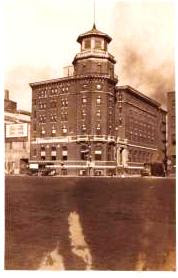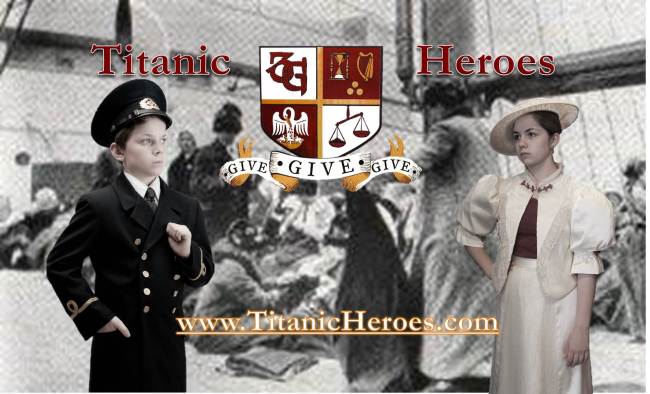 Last month, Benjamin and I took an East Coast trip with Titanic Heroes, and one of our main stops was in New York. While the history books show the evidence of New York’s link to the Titanic story, there are also clear examples of the ship’s legacy throughout the city itself. Memorials to these lost souls are still standing in various parts of New York City. The RMS Titanic has been a longtime fascination of mine, and that fascination is part of what led Benjamin and I to creating Titanic Heroes back in 2012. Thus, when we came to New York, it seemed only natural for us to tour of the various memorials of Titanic throughout the city.
Last month, Benjamin and I took an East Coast trip with Titanic Heroes, and one of our main stops was in New York. While the history books show the evidence of New York’s link to the Titanic story, there are also clear examples of the ship’s legacy throughout the city itself. Memorials to these lost souls are still standing in various parts of New York City. The RMS Titanic has been a longtime fascination of mine, and that fascination is part of what led Benjamin and I to creating Titanic Heroes back in 2012. Thus, when we came to New York, it seemed only natural for us to tour of the various memorials of Titanic throughout the city.
We started out with the remnants of Pier 54, the last remaining pier of the original Chelsea Piers from the early 1900’s. The RMS Titanic was a White Star Liner and was therefore scheduled to come into Pier 59. She of course did not, and her passengers were picked up by a Cunard Liner, the RMS Carpathia. Ironically, the Cunard and White Star Lines were rivals at the time. When the Carpathia came into New York with survivors, she dropped them off at Pier 59 and then docked at Cunard’s Pier 54.
When Cunard bought out White Star in the 1940’s, the Pier was renamed to illustrate this joining of the two lines. The Chelsea Piers complex used to be a major centerpiece of New York, and it’s incredible that Pier 54 is now its last remaining memento.

Circa 1904, this image is of the original Chelsea Piers in New York. Pier 54 is not included in this image, as it was further south.

Taken in 1950, this image shows the era when Cunard and the White Star Line, two rivals, were joined. This is Pier 54.
Through the chainlink fence that guards Pier 54 today, a haunting reminder of the pier’s glory days is still evident.

The hundreds of dock remnants from the White Star Line’s harbor days. This is where old Pier 59 for White Star was located and where Titanic would have moored.

Circa 1912, the RMS Carpathia in Pier 54. This image was taken soon after the Carpathia dropped off Titanic survivors in New York.
We then walked a little ways further, down to Jane Street. After the Titanic sank, the Carpathia brought 705 survivors of the accident to New York. The city was unsure where to put them, but it was clear that they would be taken care of in some way. The American Seamen’s Friend Society Sailors’ Home and Institute was a huge aid in this task. It took in many of the third class passengers who were too poor to find better conditions in which to stay. The Seamen’s Home was originally founded to provide an alternative for sailors who wished to stay away from the bars and saloons of New York. It was a Christian organization that provided food and housing to Titanic survivors. Additionally, a memorial service for Titanic was held there, with 125 crew members attending.
Second Officer Charles Lightoller was one of 125 surviving crew members housed at the Institute. He was one of 29 of Titanic’s crew held behind to be housed during the U.S. phase of the inquiry regarding Titanic. Onboard Titanic, Lightoller was the most senior officer to survive her sinking. He was also one of the first to realize that Titanic had hit an iceberg, and immediately began to lead women and children into lifeboats. He, with many others, spent the night on an upturned lifeboat in the freezing water. He was the last Titanic survivor picked up by the Carpathia.
A bus ride later, Benjamin and I found the next few Titanic spots in downtown New York. Grace Church has a stained glass memorial of one of Titanic‘s many heroes, Edith Corse Evans. Edith Evans was one of the many first class passengers onboard the RMS Titanic, but she was one of only four who perished when Titanic sank. Having made her way to the final lifeboat leaving the ship, there was only one seat remaining. Edith turned to the woman alongside her, Caroline Brown, and urged her to take the seat, since Caroline had children back at home. Grace Church commemorates her sacrifice with their stained glass window, but unfortunately we arrived ten minutes too late to go inside the church.

Titanic memories and memorials are scattered throughout New York, and Astor Place is just one of them.
John Jacob Astor has a street named after him in New York near Grace Church, and it’s a very small memorial to the great man that he was in 1912. The richest man in the world, he was onboard Titanic with his new, pregnant wife, Madeleine Astor. When the ship was sinking, John Jacob Astor escorted his wife to the lifeboat, ensured that she was in safely, and then stood back to allow more women and children into the lifeboats. John Jacob Astor assisted many into the boats before perishing with Titanic. His heroism was an inspiration to many.
From Grace Church, we proceeded onto the former headquarters of the White Star Line. This was the first stop for family and friends of those traveling onboard Titanic, as they searched for accurate information regarding who was saved and who perished. It was most likely here that William Byles, Father Thomas Byles’ brother, would have checked for information about his brother’s fate.

White Star Line headquarters after new of Titanic’s accident reached New York. The office was flooded with inquiries and pleas for hopeful news.
Just down the street from White Star Line’s headquarters-turned-Subway, the church of St. Elizabeth Ann Seton stands. It stands, small yet resolute, against the other skyscrapers in New York’s busy landscape. This is where many female third class passengers were brought when the Carpathia docked in New York. Here, they were provided with kindness, food, and temporary housing. In 1912, the church was simply known as the Our Lady of the Rosary Mission, but today it serves as a shrine to Saint Elizabeth Ann Seton.
Our final stop in our Titanic tour of New York was just a few blocks away from the Shrine of St Elizabeth Ann Seton. South Street Seaport has what might be the most obvious Titanic memorial in New York, but you still have to look closely for it.
Built from public donations in 1913 and shaped like a lighthouse, this tribute to Titanic stands in a busy intersection. It was originally placed at a Seamen’s Institute on South Street and on top there shone a green light. The time ball on top struck noon each day. On the lighthouse there is a small plaque that dedicates it to the Titanic.
Soon after the Titanic accident, the Nautical Magazine wrote about J. Bruce Ismay, “It is not given to everyone to be a hero.” Ismay has gone down in history as a coward, a man who took a seat in a lifeboat instead of standing back with the hundreds of other men onboard. But on the night of April 14, 1912, there were no shortage of heroes onboard the RMS Titanic. Men and women alike sacrificed their own lives for others, a principle that is no less incredible in 2015 than it was in 1912. 103 years after her sinking, the RMS Titanic is still evident throughout the city of New York, and her story is immortalized in the hundreds of heroic accounts that the accident spawned.
Since Titanic Heroes began with the story of Father Thomas Byles, Benjamin and I want to add our own memorial somewhere in New York, as a commemoration of this amazing priest’s sacrifice. For those unfamiliar with Father Byles’ story, he was a Roman Catholic priest, traveling on the Titanic to celebrate his brother’s wedding in New York. Father Byles was on deck praying when the ship struck the fatal iceberg, and he immediately went down to the steerage passengers, to inform them of the accident. Although he was offered a seat in a lifeboat twice, Father Byles refused both times, choosing instead to minister to those onboard. He went down with the Titanic, praying with passengers and offering general absolution. In memory of Father Byles’ sacrifice, Benjamin and I plan to add to the Titanic memorials in New York by focusing on the story of this heroic priest.

Benjamin and Cady in front of St. Paul’s Church. Father Byles’ brother, William, was married here after the sinking of the accident. A solemn Requiem Mass directly followed the ceremony.
There are many more memorials of Titanic scattered around the city that Benjamin and I weren’t able to visit. We’d love to see the different Titanic memorials that you come across while in New York or around the world. Take a picture of your adventures and let us know about it! Then tell us what you find and we’ll post the stories on our Facebook page.
“Greater love has no one than this: to lay down one’s for life for their friends.”
John 15:13



















 rence I bought Dr. Zimbardo’s acclaimed book, The Lucifer Effect, and began reading it. His discoveries and research both shocked and fascinated me, and the background of prison psychology created an incredibly interesting backdrop to continue on the conversation about heroes.
rence I bought Dr. Zimbardo’s acclaimed book, The Lucifer Effect, and began reading it. His discoveries and research both shocked and fascinated me, and the background of prison psychology created an incredibly interesting backdrop to continue on the conversation about heroes.

